On New Year's Day 1900 Jane Duckworth wrote in her diary [1]: Mr. J. Cunliffe Signalman Rimington went to join the Army on Dec 29 1899 he started from Rimington Station by the 7.39 train for Plymouth from there he will go to South Africa there was between fifty and sixty to see him off. They gave him a right hearty send off & he recited to them a piece of poetry & made a short speech. The young men of the village have got a subscription for his wife and children of about five shillings a week
I would imagine there would have been as many, if not more people gathered at the newly-opened station to witness the arrival of the first passenger train to stop there Monday June 2nd 1879, and given it and the passengers a cheery wave goodbye when they left. And that in the days before there had been an excited buzz in the community, and the locals and visitors travelled down the new Station Road to witness the final preparations for the opening. Was there a field trip of excited young schoolchildren to the station too? Sadly there appears to be no account of this momentous occasion in any newspapers locally or further afield. Whereas 18 years later one goods train colliding into a stationary one at the stop just minutes after the Scotch express passenger train had passed through made news in at least two London papers and two Scottish ones.
Chatburn Station opened in July 1850. It was the end of the Blackburn line until Rimington and Gisburn Stations opened almost 30 years later. In Dec 1877 there was a Wanted advertisement in the Bradford Daily Telegraph for wallers and banker hands for work on the Chatburn and Hellifield Railway. Anyone interested was to apply to J. Knowles, Swanside Viaduct, Chatburn. No rates of pay were stated. The address is very interesting because a Lancashire map of the area surveyed in 1884 shows a large building very close to the viaduct which wasn't present on earlier survey maps and doesn't exist now. So this was very likely the site office and warehouse during the building of the viaduct.
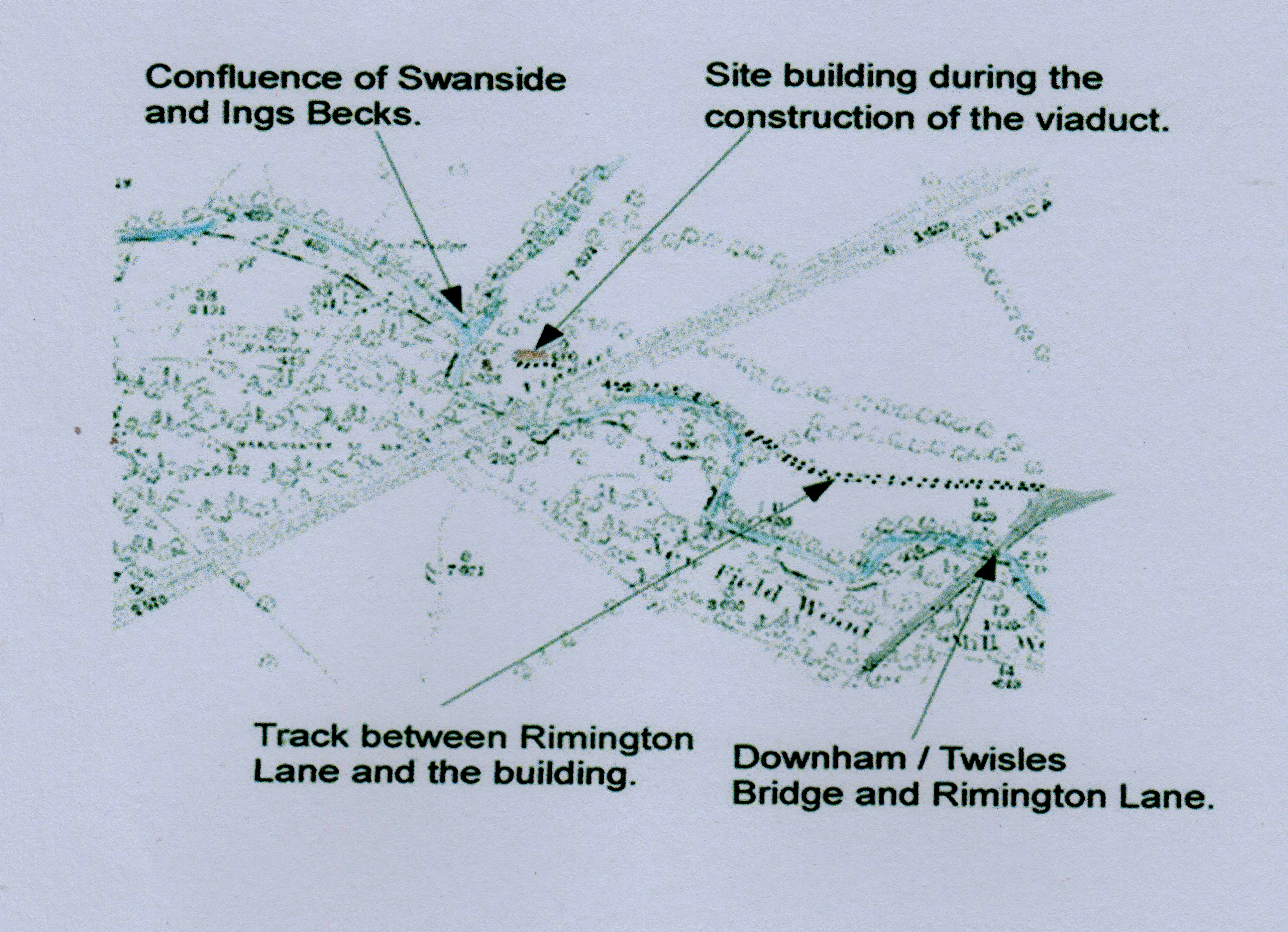
The area of Swanside viaduct in 1884.
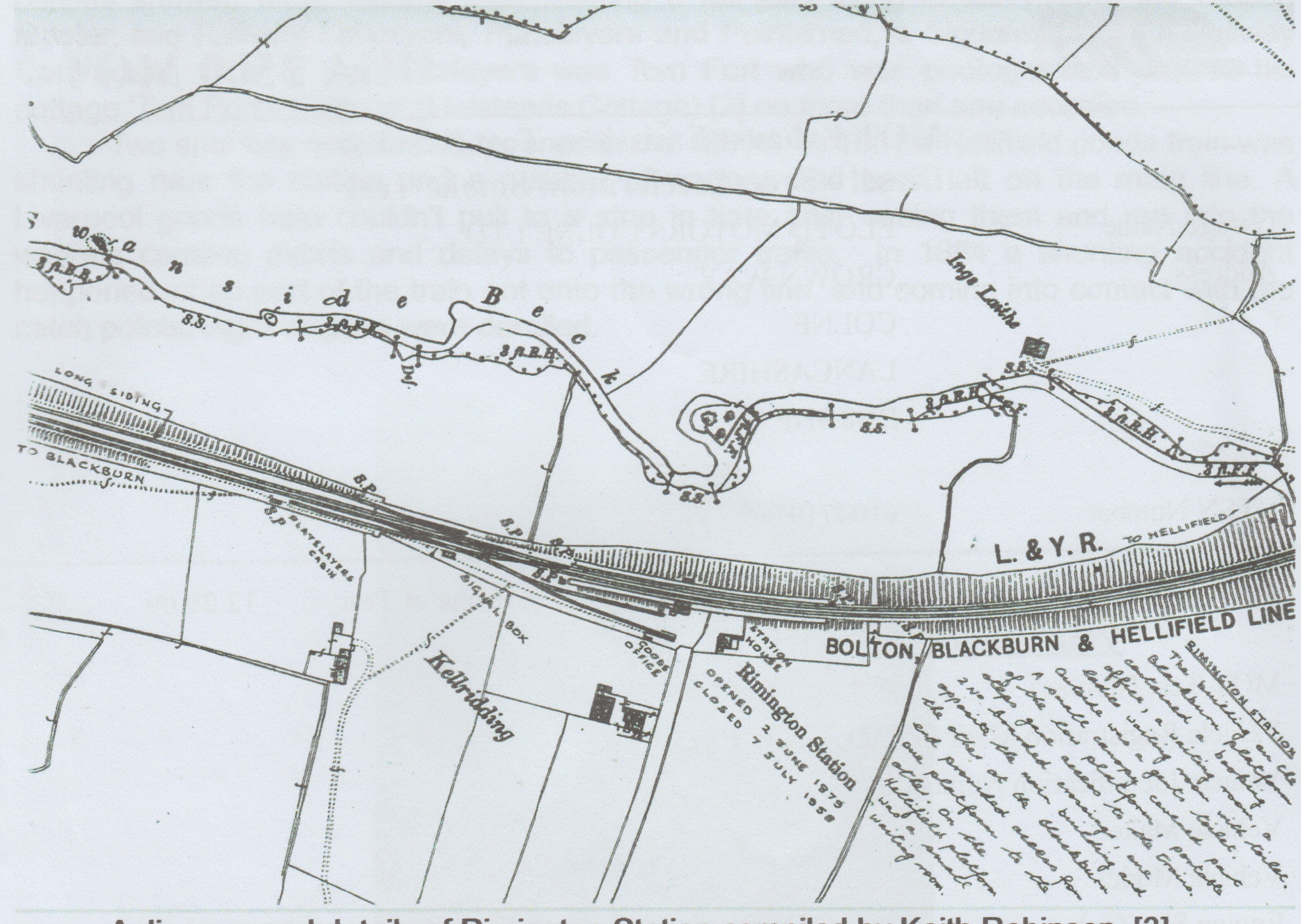
A diagram and details of Rimington Station compiled by Keith Robinson. [3]
He notes: The building on the Blackburn line contained a booking office, a waiting room, a ladies waiting room with toilet. Outside was a gents toilet. A small canopy covered the part of the low platform, portable steps gave access to the trains. 2 No boarded crossings, one opposite the main building and the other at the Blackburn end provided access from one platform to the other. On the Hellifield platform was a small waiting room.
The building was of wooden construction and had the standard LMS Hawkseye pattern nameboard. There were several oil lamps on the fences behind the platforms.
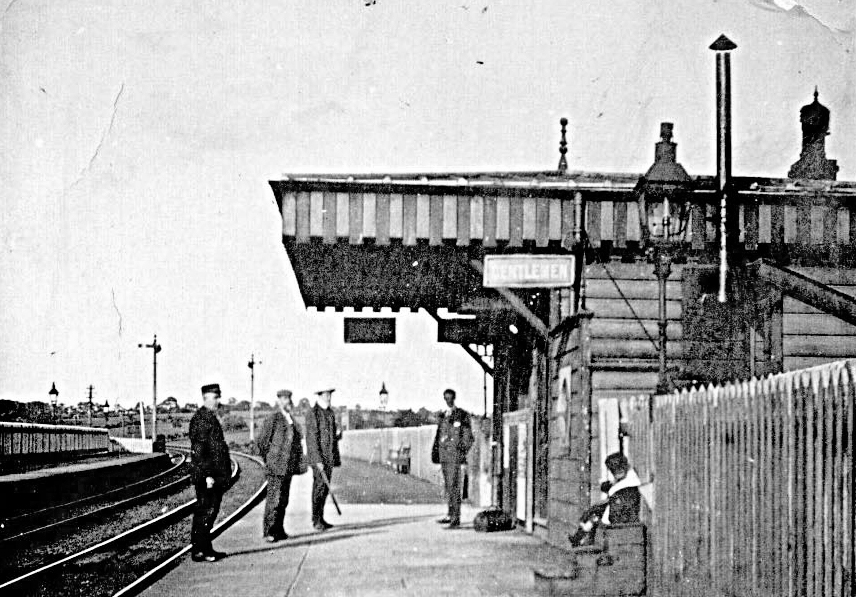
Picture showing oil lamps and the portable three-tiered steps for assess to the trains.
The railway provided a good level of employment in the community. The 1881 census showed there were 9 men working 6 rail jobs living in the village: the Station Master, two Railway Labourers, Platelayers and Pointsmen, a Signalman and a Railway Contractor. One of the platelayers was Tom Fort who was photographed outside his cottage 'Tom Fort's Cottage' (Halsteads Cottage) [2] on more than one occasion.
Two shunting accidents happened in the 1880s. In 1881 a Hellifield goods train was shunting near the station and a number of wagons had been left on the main line. A Liverpool goods train couldn't pull to a stop in time after seeing them and ran into the wagons causing debris and delays to passenger traffic. In 1884 a shunting accident happened when part of the train got onto the wrong line, and coming into contact with the catch points, eight wagons were derailed.
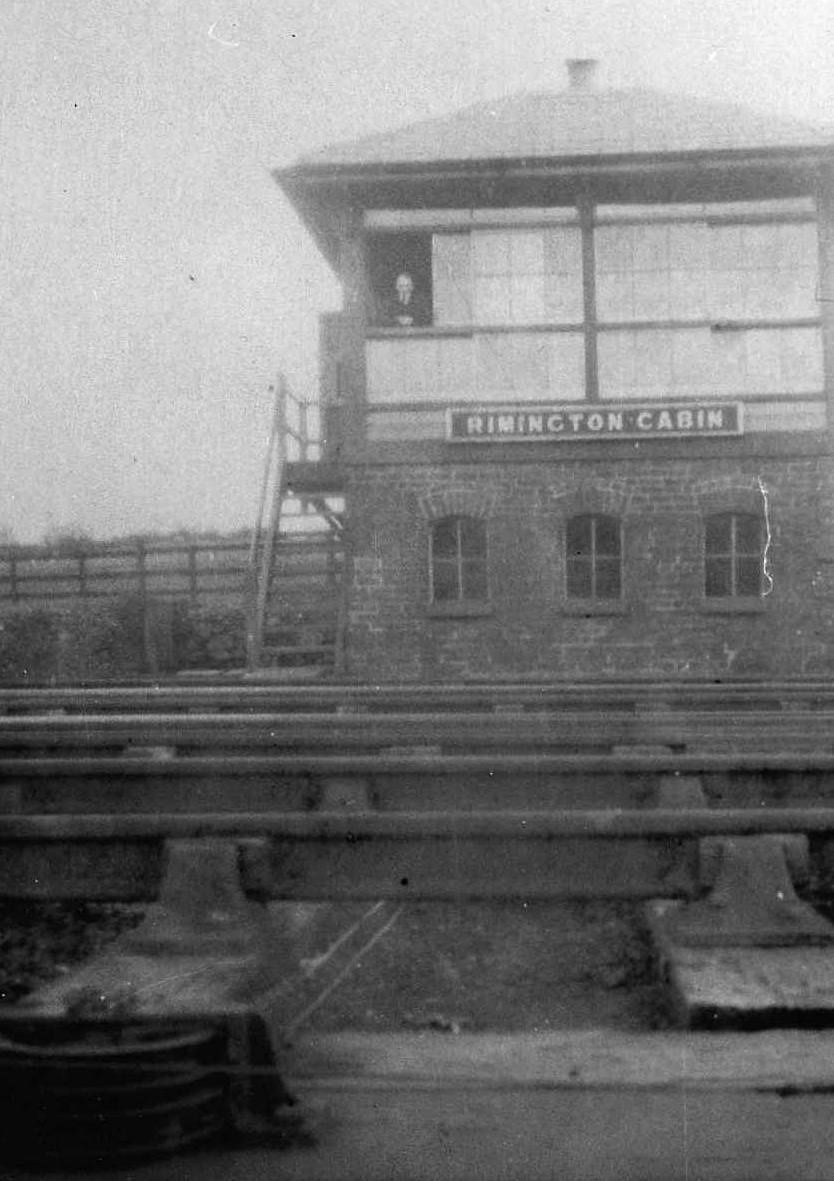
The Rimington Cabin signal box. Courtesy of Keith Robinson
In the early hours of 9th September 1897 there was a collision between two Midlands goods trains at the station resulting in several wagons being smashed and thrown off the line. Both engines were damaged but the drivers escaped almost unhurt. Had the collision happened a few minutes earlier the outcome would have been disastrous, as the Scotch express had just passed through. The incident filled a paragraph in the Freeman's Journal, Westminster Gazette, Dundee Evening Telegraph and Dundee Courier. (The Scotch express had the unofficial name 'The Flying Scotsman' since the 1870s. It became its official name on the launch of the new engine in 1924.)
Station House wasn't built until several years after the station itself was opened. In 1881 the Station Master was lodging at Bustards at the very top of Station Road. The road was an extension down the hill of the western end of Rimington Back Lane. The start of the boundary wall wasn't begun until 1886 when the width of the roadway was finally decided to be 30 feet. The contractor was Mr. James Harrison of Waddington.
In December 1940 three Rimington teenagers, William (Bill) Butler[4] and his brother Jack, and Peter Smith, pleaded guilty in court to stealing 75lbs of cordite from a sealed wagon left in the sidings due to engine failure. A platelayer had spotted sticks of cordite whilst walking the line between Gisburn and Rimington, and later found a cordite box in the stream filled with stones. The culprits were identified and they admitted having set the box and some cordite on fire. They had an extremely lucky escape in that the cordite was a type that fired and blazed as against another type which would have exploded. They were each fined £5 and ordered to share the payment of £7 19s 6d costs, which included the value of the stolen cordite.
One Sunday in October 1950 a stretch of the line between Rimington and Gisburn was the focus of a never-before-tried means of track laying. Local platelayers assisted a British Rail specialist team from Fazackerley, Liverpool, and with two rail diesel jib cranes and precision methods, they replaced more than 1000 yards of the up line track to Hellifield in six hours, such that they were lifting and replacing 6 tracks of rail more-or-less every 15 minutes.
The station was the hub of many activities regarding the village. As mentioned at the beginning people had gathered there to give J Cunliffe a hearty send off in Dec 1899 as he departed for Plymouth and then South Africa. Much later Jane Duckworth wrote in her diary: Cunliffe returned from South Africa June 7th 1901 a good many went to the Station to meet him.
It was the collection point of the local farmers' full milk kits for loading onto the 'milk train'. All the lead from the Skeleron Lead mines [5] was carted through Stopper Lane and Rimington and down to the station. Miss Babcock's show birds departed from there to be exhibited in competitions all over the country [6]. Workers caught the work train whilst grammar school children caught a later one. Horses of the Pendle & Craven Hunt were 'boxed' ready to return to Gisburn when the hunt finished at Rimington. Many Ramblers Walks started or finished at the station.
The station closed in 1958. The milk train and mining had long since stopped. And people began to prefer the freedom of choice with a motor car. If it hadn't closed then, it surely would have felt the infamous blade of the Beeching Axe 5 years later.
Several peoples' reminiscences of the station are in the attached PDF file. Some first appeared in 'Time Flies Swift Away Rimington Remembered & Middop Memories' published 2003. Many of the contributors have now sadly passed away.
I leave the last words to the unknown person who lamented the closure of the station by leaving the following (not quite accurate) note on the Clitheroe Advertiser and Times editor's desk:
Rimington Station
Died July 5th 1958
at 11.37pm
Aged 83
(Actually aged 79)
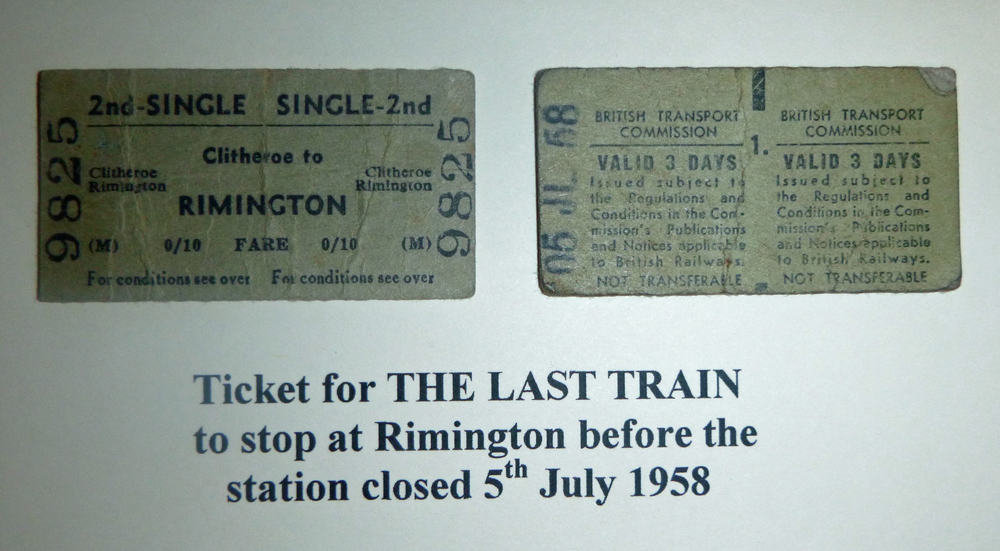
Tickets for the last train to stop at Rimington before the station closed 5 July 1958
Courtesy of John and Barbara Spencer
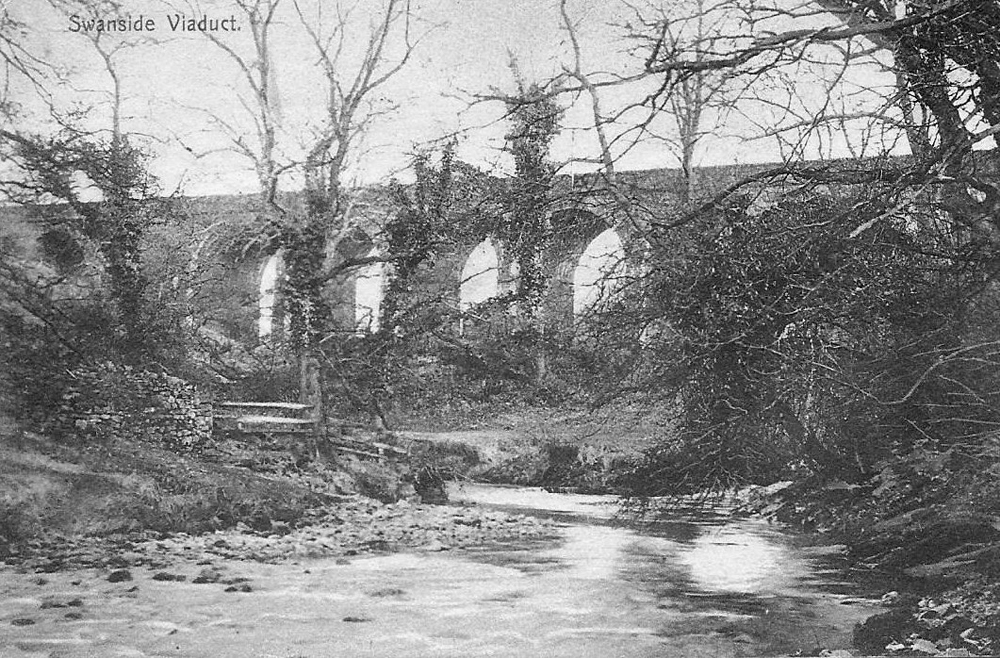
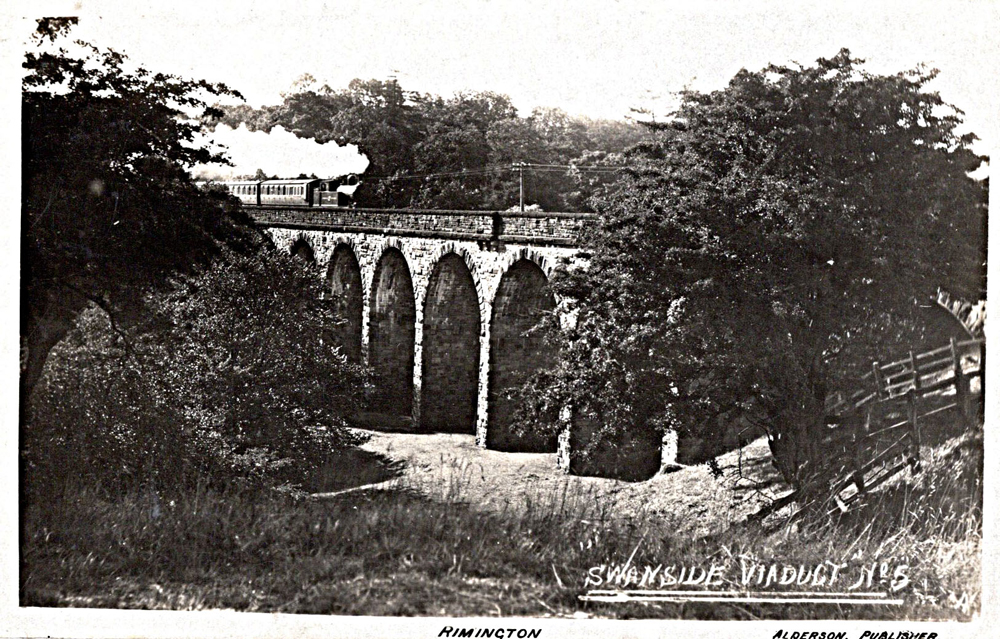
View of Swanside Viaduct from downstream, courtesy of Ruth Collinson Steam train going over viaduct
Brian Stott April 2023
With grateful thanks to Keith Robinson, John & Barbara Spencer, Trevor & Lesley Marklew and Ruth Collinson.
References:
1. Snippets and Cuttings - Extracts from two 19thC Rimington diaries.
2. Rimington Images Past and Present – Stoops Lane to the A682
3. See attached PDF file of reminiscences.
4. See attached PDF file of reminiscences
5. Rimington Heritage – Industrial Archaeology & People from the Past sections
6. Rimington Heritage - Lost Businesses - Miss Babcock's Prize Poultry Yards.
